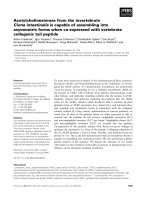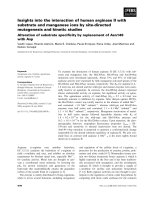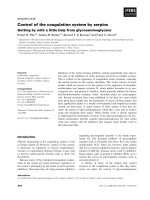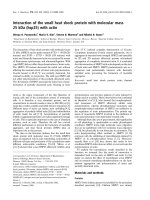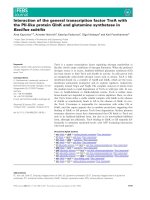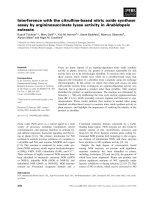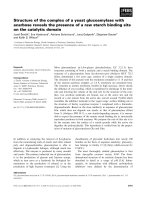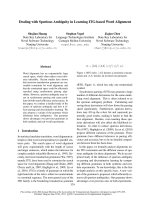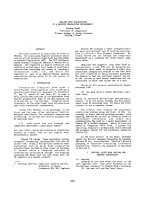Báo cáo khoa học: "Dealing with the delirium dilemma" pot
Bạn đang xem bản rút gọn của tài liệu. Xem và tải ngay bản đầy đủ của tài liệu tại đây (34.37 KB, 2 trang )
335
CAM-ICU = confusion assessment method for the intensive care unit; ICU = intensive care unit; LOS = length of stay; NMBA = neuromuscular
blocking agent.
Available online />Abstract
Delirium is a frequently occurring but often under-diagnosed and
under-treated problem in the intensive care unit (ICU). It has been
linked to adverse outcome, increased length of stay and higher
mortality in critically ill patients. A study by Thomason and coworkers
published in this issue of Critical Care deals with the issue of
delirium and its consequences in less severely ill patients. This
commentary aims to provide context for this study, discussing its
potential implications as well as the potential therapeutic and
preventive measures in patients with hyperactive or hypoactive delirium
Until the early 1990s it was common practice to administer
large doses of sedatives, analgetics and neuromuscular
blocking agents (NMBAs) routinely to mechanically ventilated
patients. The underlying assumption was that, without such
medications, patients could not tolerate invasive intensive care
unit (ICU) treatments and that sedation and paralysis would
allow the patient to ‘rest’ and recover. Practices and treatments
used for general anaesthesia during major surgery were often
simply continued for longer term management in the ICU.
This attitude began to change in the mid-1990s, with the
realization that prolonged use of high-dose NMBAs, sedatives
and opiates was associated with increased risk for critical
illness polymyoneuropathy, nosocomial infections, adverse
outcomes and increased length of stay (LOS) in the ICU.
Kress and coworkers [1] reported that daily interruption of
sedative drug infusions to assess whether sedation could be
discontinued or tapered led to reduced ICU LOS (6.4 days
versus 9.9 days) and shorter duration of mechanical ventilation
(4.9 days versus 7.3 days). These and other findings led to a
marked decrease in the use of sedatives, and especially
NMBAs, in ICUs worldwide. This development was assisted
by changes in ventilatory strategies and technical
improvements in mechanical ventilators. Current Society of
Critical Care Medicine guidelines recommend that NMBAs be
used to manage ventilation only when all other means have
been tried without success [2], and that sedation should be
regularly assessed and tapered as early as possible [3].
These changes led to huge increases in the number of
(semi)conscious patients in the ICU. It was soon realized that
many of these patients, especially those with more severe
illness, develop alterations in their mental status during the
acute phase of critical illness and/or in later phases. Clinical
studies showed that 70–80% of critically ill patients [4-6] and
16–22% of less severely ill patients [7,8] develop delirium at
some stage in their ICU stay. Risk factors include increased
severity of illness, advanced age, medical comorbidity, pre-
existing cognitive impairment, sleep deprivation, and various
medications [5]. Partly because of its high incidence, ‘ICU
psychosis’ was initially regarded as an almost ‘normal’
consequence of prolonged ICU stay – a self-limiting
morbidity due to the combined effects of the patient’s illness
and administration of sedatives. However, this view appears
to be mistaken; numerous studies have shown that delirium is
associated with increased morbidity and mortality, and
prolonged LOS in the ICU [7-9]. In one study conducted in
critically ill patients [10] mortality was 34% in patients who
developed delirium versus 15% in those who did not. After
adjusting for covariates the hazard ratio was 3.2 (95%
confidence interval 1.4–7.7). However, a link between
delirium and adverse outcome has not yet been demon-
strated in less severely ill patients.
In this issue of Critical Care, Thomason and coworkers [11]
assessed the impact of delirium in a group of non-
mechanically ventilated patients with moderate severity of
illness (median Acute Physiology and Chronic Health
Evaluation II score 15). The authors observed a surprisingly
high incidence (48%) of delirium, even in this ‘mild’ category
of patients. Previous studies had reported a somewhat lower
Commentary
Dealing with the delirium dilemma
Kees H Polderman and Ellen Smit
Senior consultant in Intensive Care Medicine, Department of Intensive Care, VU University Medical Center, Amsterdam, The Netherlands
Corresponding author: Kees H Polderman,
Published online: 17 June 2005 Critical Care 2005, 9:335-336 (DOI 10.1186/cc3755)
This article is online at />© 2005 BioMed Central Ltd
See related research by Thomason et al. in this issue [ />336
Critical Care August 2005 Vol 9 No 4 Polderman and Smit
incidence [7,8]; this may be explained by exclusion of high
risk patients and shorter follow-up periods in some of these
studies [8]. Thomason and coworkers [11] followed all non-
ventilated patients admitted during the 11-month study period
until death or hospital discharge. They reported that delirium
was associated with significantly increased LOS in the ICU
(average 1 day) and hospital (average 2 days). There was a
trend toward greater mortality in patients who developed
delirium (19% versus 6%; P = 0.11), which disappeared after
adjustment for covariables. Nevertheless, the potential
reduction in length of stay alone would justify a more intensive
effort to screen and aggressively treat patients with delirium –
even those with only moderate severity of illness.
One problem may be establishing a reliable diagnosis of
delirium. Hyperactive delirium is easy to spot, but
identification can be more difficult with the more frequently
occurring hypoactive delirium. There may also be some
discussion regarding treatment; some intensivists and
psychiatrists prefer to adopt a ‘wait and see’ approach, partly
based on fear of side effects of treatment with antipsychotics
such as haloperidol. This attitude may be more prevalent
when a patient has hypoactive delirium, which is less ‘visible’
and therefore may be less alarming to the medical and
nursing staff. However, the evidence from this and other
studies strongly suggests that this attitude is misguided, and
that all forms of delirium should be treated promptly. In
addition, a proactive approach appears warranted, with early
and regular screening for delirium and basic preventive
measures such as avoiding sleep deprivation, cognitive
stimulation, visual and hearing aids, music listening, early
mobilization, ICU noise reduction strategies, and avoiding
dehydration, electrolyte disorders and hypoxaemia [12].
Pharmacological options include discontinuation of drugs
that can cause or aggravate delirium (including
benzodiazepines and narcotics, which are often
inappropriately used in the ICU to treat ‘confusion’), and if
necessary treatment with antipsychotics such as haloperidol.
Other neuroleptic agents with broader receptor affinities
(such as risperidol, olanzapine, ziprasidone, etc.) may be
(more) effective in nonagitated delirium, but have not been
well studied in the ICU setting. For the moment haloperidol
remains the drug of choice to treat delirium in the ICU [3].
Patients should be carefully monitored for side effects such
as QT prolongation, especially because many other drugs
that are commonly used in the ICU (macrolides, fluoroquino-
lones, azole antifungals, amiodarone, some calcium channel
blockers, etc.) can also cause QT prolongation.
Assessment systems such as the confusion assessment
method for the ICU (CAM-ICU) have been designed
specifically to screen for delirium in patients who are unable
to communicate verbally [13]. Although some key features of
delirium, such as inattention and disorganized thinking, can
be difficult to assess in mildly or moderately sedated patients,
systems such as CAM-ICU present a great step forward in
the standardized systematic assessment of confusion and
delirium. They can certainly be reliably used in nonventilated
patients, as was shown in this study [11].
Currently, few intensivists routinely screen their patients for
delirium. In particular, ‘silent’ (hypoactive) delirium is often
overlooked, and even when diagnosed it is often left
untreated. The report by Thomason and coworkers [11] again
demonstrates that this attitude must change; inattention may
be a basic feature of delirium, but it should not be a basic
feature of our attitude toward delirium in the ICU.
Competing interests
The author(s) declare that they have no competing interests.
References
1. Kress JP, Pohlman AS, O’Connor MF, Hall JB: Daily interruption
of sedative infusions in critically ill patients undergoing
mechanical ventilation. N Engl J Med 2000, 342:1471-1477.
2. Murray MJ, Cowen J, DeBlock H, Erstad B, Gray AW Jr, Tescher
AN, McGee WT, Prielipp RC, Susla G, Jacobi J, et al.: Task Force
of the American College of Critical Care Medicine (ACCM) of the
Society of Critical Care Medicine (SCCM), American Society of
Health-System Pharmacists, American College of Chest Physi-
cians: Clinical practice guidelines for sustained neuromuscu-
lar blockade in the adult critically ill patient. Crit Care Med
2002, 30:142-156.
3. Jacobi J, Fraser GL, Coursin DB, Riker RR, Fontaine D, Wittbrodt
ET, Chalfin DB, Masica MF, Bjerke HS, Coplin WM, et al., Task
Force of the American College of Critical Care Medicine (ACCM)
of the Society of Critical Care Medicine (SCCM), American
Society of Health-System Pharmacists (ASHP), American College
of Chest Physicians: Clinical practice guidelines for the sus-
tained use of sedatives and analgesics in the critically ill adult.
Crit Care Med 2002, 30:119-141.
4. Bergeron N, Skrobik Y, Dubois MJ: Delirium in critically ill
patients. Crit Care 2002, 6:181-182.
5. Dubois MJ, Bergeron N, Dumont M, Dial S, Skrobik Y: Delirium in
an intensive care unit: a study of risk factors. Intensive Care
Med 2001, 27:1297-1304.
6. Ely EW, Siegel MD, Inouye S: Delirium in the intensive care
unit: An under-recognized syndrome of organ dysfunction.
Semin Respir Crit Care Med 2001, 22:115-126.
7. Bergeron N, Dubois MJ, Dumont M, Dial S, Skrobik Y: Intensive
Care Delirium Screening Checklist: evaluation of a new
screening tool. Intensive Care Med 2001, 27:859-864.
8. Lin SM, Liu CY, Wang CH, Lin HC, Huang CD, Huang PY, Fang
YF, Shieh MH, Kuo HP: The impact of delirium on the survival
of mechanically ventilated patients. Crit Care Med 2004, 32:
2254-2259.
9. Ely EW, Gautam S, Margolin R, Francis J, May L, Speroff T,
Truman B, Dittus R, Bernard R, Inouye SK: The impact of delir-
ium in the intensive care unit on hospital length of stay. Inten-
sive Care Med 2001, 27:1892-1900.
10. Ely EW, Shintani A, Truman B, Speroff T, Gordon SM, Harrell FE
Jr, Inouye SK, Bernard GR, Dittus RS: Delirium as a predictor of
mortality in mechanically ventilated patients in the intensive
care unit. JAMA 2004, 291:1753-1762.
11. Thomason JW, Shinatani A, Peterson JF, Pun BT, Jackson JC, Ely
EW: ICU delirium is an independent predictor of longer hospi-
tal stay: a prospective analysis of 260 non-ventilated patients.
Crit Care 2005, 9:R375-R381.
12. Inouye SK, Bogardus ST Jr, Charpentier PA, Leo-Summers L,
Acampora D, Holford TR, Cooney LM Jr: A multicomponent
intervention to prevent delirium in hospitalized older patients.
N Engl J Med 1999, 340:669-676.
13. Ely EW, Inouye SK, Bernard GR, Gordon S, Francis J, May L,
Truman B, Speroff T, Gautam S, Margolin R, et al.: Delirium in
mechanically ventilated patients: Validity and reliability of the
confusion assessment method for the intensive care unit
(CAM-ICU). JAMA 2001, 286:2703-2710.
